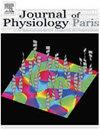The insect mushroom body, an experience-dependent recoding device
Abstract
The insect mushroom body is a higher order integration center involved in cross-sensory integration and memory formation. The relatively large mushroom bodies of social Hymenoptera (e.g. bees) have been related to the demands of a social system and the neural processes required to allow the animal to navigate in an ever-changing environment. Here I review studies aiming to elucidate the neural processes that take place at the input and the output sites of the mushroom bodies and that underlie cross-sensory integration, associative learning, memory storage and retrieval. Highly processed sensory information is received at modality-specific compartments of the input site, the calyx. The large number of intrinsic neurons of the mushroom body receive multiple sensory inputs establishing combinations of processed sensory stimuli. A matrix-like memory structure characterizes the dendritic area of the intrinsic neurons allowing storage of rich combinations of sensory information. The rather small number of extrinsic neurons read out from multiple intrinsic neurons, thereby losing their sensory coding properties. The response properties of these neurons change according to the value of stimulus combinations experienced. It is concluded that the mushroom bodies transform the highly dimensional sensory coding space into a low dimensional coding space of value-based information. A model of such an experience-dependent recoding device is presented and compared with the available data.

 求助内容:
求助内容: 应助结果提醒方式:
应助结果提醒方式:


